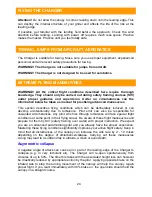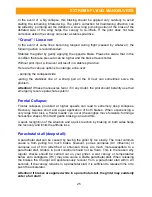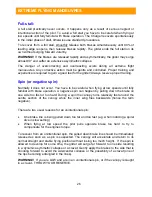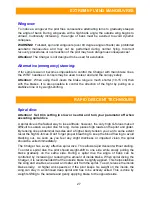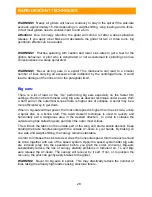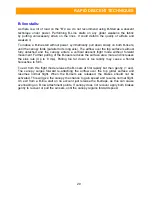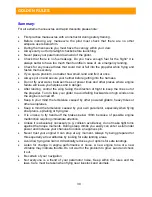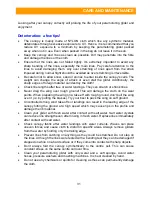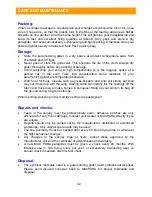
17
FLYING THE CHARGER
have safely taken off continue heading into the wind. Release the brakes to gain enough
altitude to allow you to get into your harness safely.
Experienced paraglider pilots that start paramotoring have a tendency to lean forward
with slightly applied brakes. When taking off with a paramotor you need to stand up
straight and allow the thrust of the engine to push your body horizontally forward rather
than diagonally down.
It is important to not get into the harness as soon as you leave the ground. Right after
take-off you are relatively low to the ground. The possible danger is if the engine
happens to quit or loose thrust you quickly will be put back on the ground. Not rushing
into your seat/harness allows your legs to act as landing gear instead of the bottom of
your paramotor.
The recommended technique of getting into your harness is to climb to a safe height
into the wind and then gently throttle back before getting into the seat. If you need to
use your hand to help you get into your harness, be sure to put the brake toggle on the
magnet first to avoid it being sucked into the prop. Also note that properly fastened leg
straps makes getting into the harness much easier. Check this before take-off in a
simulator or with your paramotor instructor.
WARNING!!
Do not jump or lift your legs immediately after or during your take off!
This could have disastrous consequences when done with a paramotor if the wing has
not reached the proper take off speed to create the necessary lift. Keep running, keep
running and keep running until you are running through the air.
WARNING!!
Do not attempt to get into the seat while holding the brake handles.
WARNING!!
Do not use the forward launch technique in very strong winds. Make sure
you don't pull the risers too much towards yourself or downwards as this can cause a
frontal collapse or make an asymmetric collapse during take-off.
Reverse launch Technique
The Charger is easy to reverse launch.
The most important skill to perform the reverse launch successfully is to fully understand
ground handling. You need to be able to keep the wing directly overhead and into wind
while taking off on flat ground. When doing a reverse launch in strong winds the
Charger can surge forward quickly or lift off sooner than desired. To avoid this, walk
towards the canopy during inflation. We recommend pulling the trimmers down 2-3 cm
from the neutral position.
To reverse launch the Charger in wind, get the canopy over your head by using the A
and D riser method. Holding onto the D lines stop it from over shooting and guiding the
A lines in the opposite hand help it come up. This stops you from applying both brakes
and pushing your hands back towards the propeller.
Содержание CHARGER
Страница 1: ...1 ...
Страница 10: ...10 TRIMMING ...
Страница 35: ...35 LINE PLAN SCHEME ...
Страница 38: ...38 ...
Страница 40: ...40 ...






















